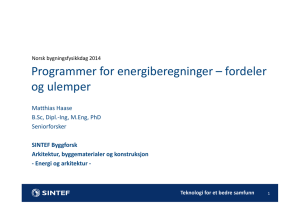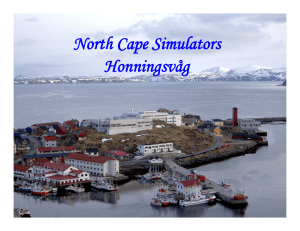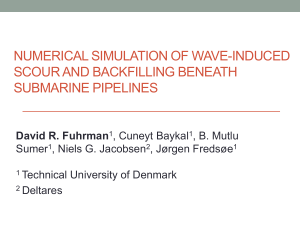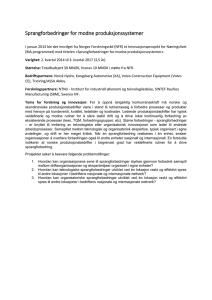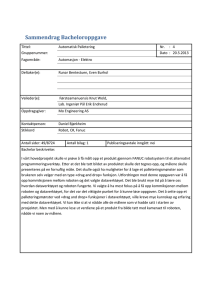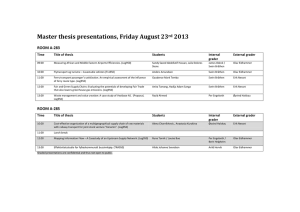OPERATIVE SIMULATION
advertisement
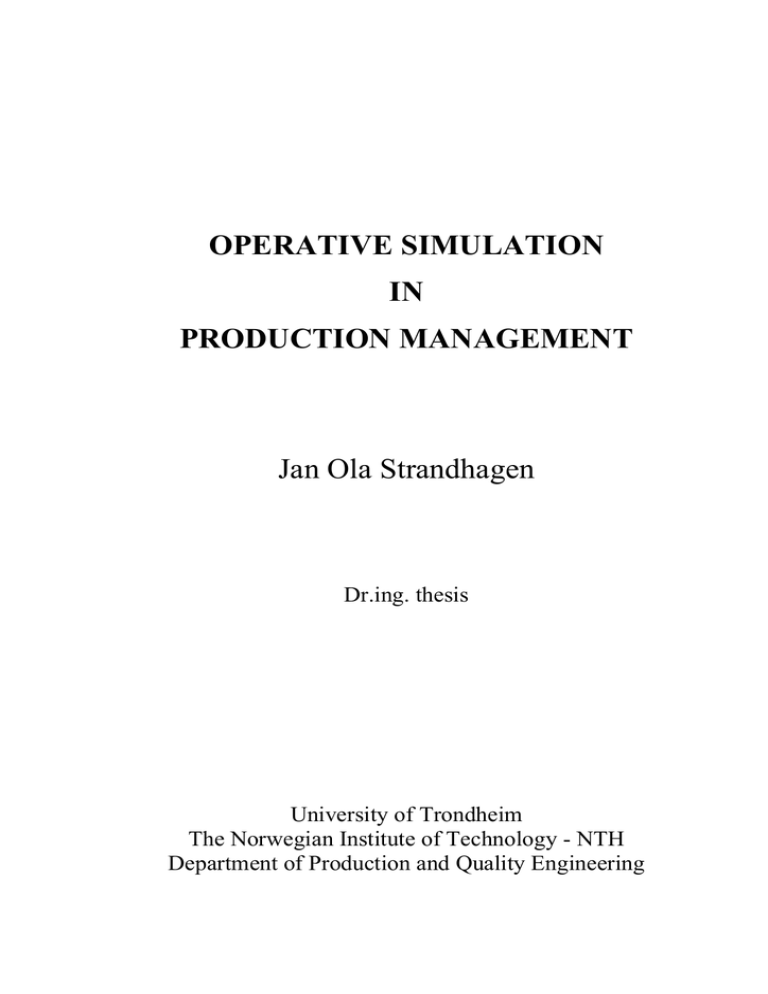
OPERATIVE SIMULATION IN PRODUCTION MANAGEMENT Jan Ola Strandhagen Dr.ing. thesis University of Trondheim The Norwegian Institute of Technology - NTH Department of Production and Quality Engineering - II - Trondheim, Norway - III - - IV PREFACE Simulation in manufacturing has been studied with increased efforts over the last decades. It has gained a position in research as an important tool to analyse and understand manufacturing systems. But the position of simulation as an operative tool in industry was not, and is still not, commonly accepted as a useful aid to improve competitiveness. This was the case several years ago, when NTNF, The Norwegian Council for Scientific and Industrial Research, launched the SIMMEK programme at NTH/SINTEF. A few years later a Dr.ing. scholarship was granted to me, giving me opportunity to study and develop this field together with some Norwegian companies. This thesis presents the research worked performed, the simulation tool SIMMEK, as well as one industrial project where simulation and SIMMEK have been applied with success. The report is written in an informal way (i.e. non-mathematical), in order to make it as easy accessible as possible. It is trying to describe the possible benefits from using simulation in industry, and showing the facilities of the SIMMEK tool. The detailed coding of SIMMEK, the mathematical formulas used, etc., is not presented here. An introduction to simulation is given. A similar introduction to production management is not given, as most readers are believed to have their background from this field. Structure of thesis The thesis is made up of nine sections, of which the last is the summary of the work and future research areas. Section 1, Introduction, gives an overview of the field, as well as a limitation of the scope of work. Section 2 gives the background of the research programme and the industrial potential. It also has references to some surveys both in Norway and the UK. Sections 3, 4 and 5 give a detailed description of the SIMMEK tool, how it works, what it can do, and what results to get from using it. Section 4 focuses on verification and validation in simulation. Section 6 is a description of the first major case where SIMMEK was applied. It was in Raufoss A/S, a car parts manufacturing company. A table in Section 6 lists other industrial projects where SIMMEK has been applied. Sections 7 and 8 are descriptions of work as well as ideas on how to use and develop simulation tools like SIMMEK in the future. Section 9 summarises the work, and gives a summary of future research areas. The references are followed by lists of figures, tables and symbols/terms/ expressions. -VAcknowledgements It is with gratitude, humbleness and pride that I present this document. Gratitude towards all those who have with enthusiasm inspired, assisted and worked to make me able to perform my work and complete this thesis. Humble to the fact that without this support, this thesis would never have come to be reality. But also with pride, because I have put the best of my abilities and effort into the work. My deepest and most sincere thanks go to Eirik Borgen at SINTEF. Eirik and I have been working together for several years, and I have learned to appreciate his skills and attitude to his work. But most of all I admire his loyalty and willingness to follow up ideas and wishes that I have come up with during our collaboration with SIMMEK. Eirik has been the designer and programmer of SIMMEK, and much of what is presented here would still be available only on paper if it had not been for Eirik. I would also very much like to express my gratitude to my family, my mother and father who always supported me in whatever direction I decided to go in life. I can only pity that my father did not live long enough to see the final thesis. But I am also sure that he was the one who with most blind confidence believed that it would be a success. Although he was the one who could live with any result, as long as I did my best. For Helle, whose patience with my absence from home and family seems to be unlimited, my gratitude is equally large. The constant and powerful support from my supervisor, Professor Øyvind Bjørke, during these years, where strongly varying progress is a keyword, is also one of the reasons for this thesis ever being completed. For this I am very grateful. I was introduced to the SIMMEK research programme by Einar Ramsli and Per Aage Nyen, and I had the pleasure to work under their stimulating supervision for several years. I would also like to thank NTNF, represented by Chairman of the SIMMEK programme Professor Sigurd Støren, for granting my study, and for the support from NTH and SINTEF. Many thanks also to Raufoss AS for allowing me use their plant as an experimental ground for SIMMEK. A special thanks to Per Olav Olsen and his crew for spending so much time on this true research project. Gunnveig Grøtan has been, as usual, very helpful and skilful in trying to put the results into a report which is hopefully well readable and without too many misprints. A number of people has assisted in the work. I hope that none of them are left out of this list; Tom Fagerhaug, Mari Kuusisto, Espen Sommerfeldt, Reka Toth, Solfrid Sørensen. A thank you to all my friends, colleagues at NTH and SINTEF and others, for the interest you have shown in my work, the possible completion of it, and all your encouragement. I dedicate this work to the memory of my dad, and to my son Jo. Trondheim 1994-03-05 Jan Ola Strandhagen - VI SUMMARY The importance of numerical simulation can be described by the viewpoint that there are three pillars in scientific and technology research; analytic methods, experimental methods and numerical simulation. Simulation is a numerical technique for conducting experiments on a digital computer, which involves certain types of mathematical and logical relationships necessary to describe the behaviour and structure of a complex real world system over extended periods of time, Naylor [5]. Simulation is normally used for one of these two purposes; * * As a decision support tool For understanding and learning about complex systems The application of simulation in manufacturing can be supporting decisions of strategic, tactical or operational character. A large research programme, SIMMEK, was launched at NTH/SINTEF in 1985, financially supported by the Norwegian Council for Scientific and Industrial Research, NTNF. Within this programme my work has been to examine the need for, specify and test a simulation tool for operative use in production management. The tool, SIMMEK, is based on discrete event simulation techniques. As any other computer tool, SIMMEK has its advantages and disadvantages. On the positive side the following points are most essential; * * * * Supporting strategic, tactical and operational production management decisions Includes economical analysis Models and results presented by spreadsheets and graphics making it * quick to model * easy to post process the data * easy to read and interpret * easy to integrate No programming or pseudo programming needed On the negative side, SIMMEK has what could be called lacks of facilities compared to other existing packages. The most important of them are; * * * No animation No programming facilities * Modelling limitations * No integration possibilities Available only on Macintosh * Slow in changing large set of parameters The three items in the right column has certainly been solved with the new version of SIMMEK, SIMMEK-II, made outside the work presented in this report. Model validation has been given special concern in the development of SIMMEK, because the consequences of making invalid models may be that wrong conclusions are made, and the costs of using simulation are increased. Special features of SIMMEK have therefore been implemented to help the user in validating models. The results in SIMMEK are organised along two axis; one axis giving the different categories of results, the other giving what could be called the time scope of the results. These two lists show the general set of results in SIMMEK. Along the first axis we have results in four categories; * * * Economical and market service results for the total model Product results. Per production order or per product type Resource results - VII * Experimental facts Along the second axis there are five major points. These factors concern the simulation time span over which they are captured, as well as the degree of detail of the results. All these results are produced into Excel spreadsheets; * * * * * Estimated expected values Average results/values from one replication Detailed results/values from one replication Average results from many replications A trace of all events from a selected period of one replication Raufoss AS is one of Norway’s leading manufacturing companies. Its main products are ammunition and military equipment as well as aluminium and plastic parts for the automotive industry. Raufoss produces bumpers and chassis parts for many of the leading car manufacturers in Europe and the USA. I used SIMMEK at Raufoss to see the effects of reduction of set-up times, as well as to find "optimal" lot sizes. In other words it was a simulation experiment trying to find a better way of operating an existing system, hence it was simulation used for a tactical purpose. The conclusion from this project can be summarised as follows; * * * The study showed potentials of increased inventory turnover by 30 %. It was possible to model and conclude about a large manufacturing plant The tool was useful for training personnel working in a plant More than 15 companies from varying types of industries have now used the SIMMEK tool. Industrials as well as researchers and students have learned to use the tool. The work on SIMMEK has been continued at NTH/SINTEF, and the major improvements are; * * * All input can now be given in the Excel format Data input from an MRP II based production management system Available on both PC - MS/DOS and Macintosh I see the following topics as the ones that effort should be put into to enlarge the number of companies and situations where simulation may be applied; * * * * Improving facilities of existing tools More integration facilities More automated/computerised functions Speed up the learning, modelling and simulation time I see a future development where the competitiveness of manufacturing companies will be measured by how fast they can develop and manufacture new products into a customer driven, global and unstable market. In this situation key factors will be the ability to engineer and produce prototypes and products very rapidly and concurrently, handling the uncertainty of the situation. A key factor will be virtual manufacturing, i.e., making decisions based on models and simulations. - VIII - SAMMENDRAG Viktigheten ved numerisk simulering kan beskrives med det synspunkt som sier at det finnes tre pilarer i vitenskapelig og teknisk forskning, analytiske metoder, eksperimentelle metoder og numerisk simulering. Simulering er en numerisk teknikk hvor forsøk gjøres på en datamaskin, som inkluderer visse typer av matematiske og logiske forhold som er nødvendig for å beskrive virkemåten og strukturen til et komplekst virkelig system over gitte tidsperioder, Naylor [5]. Simulering kan anvendes på to hovedområder; * * Som et beslutningsstøtteverktøy For forståelse av og opplæring i komplekse system Anvendelsesområdene for produksjonssimulering spenner over strategiske, taktiske og operative beslutninger innen produksjonsledelse. Et stort forskningsprogram, SIMMEK, ble igangsatt ved NTH/SINTEF i 1985, med finansiell støtte fra Norges Teknisk-Naturvitenskapelige Forskningsråd, NTNF. Innen dette programmet har oppgaven min vært å undersøke behovene for, spesifisere og teste et simuleringsverktøy for operativ bruk i produksjonsledelse. Verktøyet, SIMMEK, er basert på diskret hendelses simuleringsteknikk. Som ethvert annet data verktøy har SIMMEK fordeler og ulemper. De viktigste positive sidene er; * * * * Beslutningsstøtte i strategisk, taktisk og operativ produksjonsledelse Inkluderer økonomisk analyse Modeller og resultater blir presentert ved regneark og grafikk som gjør det * raskt å modellere * enkelt å etterbearbeide data * enkelt å lese og oversette * enkelt å integrere Brukervennlig, ingen programmeringskunnskaper er nødvendig På den negative siden kan vi si at SIMMEK mangler noen muligheter sammenlignet med andre program. De viktigste her er; * * * Ingen animering Ingen programmeringsmulighet Begrensninger i modellering * * * Ingen integrasjonsmuligheter Tilgjengelig bare på Macintosh Langsom når store parametersett skal forandres De tre punktene i høyre kolonne er løst i SIMMEKs nyeste versjon, SIMMEK-II, som ikke er omtalt i denne rapporten. Modellgyldighet (validitet) er tillagt spesiell vekt når det gjelder utviklingen av SIMMEK, idet konsekvensene av å lage ugyldige modeller kan medføre at feil konklusjon trekkes, og at kostnadene ved å benytte simulering øker. Spesielle trekk ved SIMMEK er derfor blitt implementert for å hjelpe brukeren til å gjøre modeller gyldig. Resultatene i SIMMEK er organisert langs to akser, en akse viser de forskjellige resultatkategoriene, den andre viser det vi kan kalle resultatenes tidsperspektiv. De to følgende listene viser de generelle resultatene i SIMMEK. Langs den første aksen har vi resultater i fire kategorier; - IX * * * * Økonomiske og markedsresultater for den totale modellen Produktresultatene, pr. produksjonsordre eller pr. produkttype Ressursresultatene Eksperimentelle fakta Langs den andre aksen er det 5 vesentlige punkt, som går på simuleringstiden så vel som resultatenes detaljeringsgrad. Alle disse resultatene er laget i Excel regneark. * * * * * Estimerte forventede verdier Gjennomsnittlige resultater/verdier fra en replikasjon Detaljerte resultater/verdier fra en replikasjon Gjennomsnittlige resultater fra mange replikasjoner En liste av alle hendelser i en valgt periode til en replikasjon Raufoss AS er en av de ledende produksjonsbedrifter i Norge. Hovedproduktene er ammunisjon og militært utstyr, så vel som aluminium- og plastdeler for bilindustrien. Raufoss produserer støtfangere og chassisdeler til mange av de ledende bilprodusentene i Europa og USA. Hensikten med simuleringsforsøket ved Raufoss var å se virkningene når omstillingstidene ble redusert, samt å finne optimale seriestørrelser. Det var med andre ord et simuleringsforsøk for å finne en bedre måte å operere et eksisterende system på, følgelig ble simulering benyttet for et taktisk formål. Følgende konklusjon fra dette prosjektet kan trekkes; * * * Forsøket viste potensial for økt vareomløpshastighet på 30% Det var mulig å modellere og trekke konklusjoner fra en stor bedrift SIMMEK er nyttig for personellopplæring i en bedrift Mer enn 15 bedrifter fra ulike typer industri har nå benyttet SIMMEK-verktøyet. Både industrifolk, forskere og studenter har lært å bruke verktøyet. Arbeidet med SIMMEK har fortsatt ved NTH/SINTEF, og de største forbedringene er; * * * All input kan bli gitt på Excel-format Data input kan mottas fra et MRP II basert MPS system Tilgjengelig både på PC-MS/DOS og Macintosh Jeg mener det bør legges vekt på følgende områder for videre forskning og utvikling, slik at stadig flere bedrifter kan ta i bruk simulering; * * * * Forbedre brukervennligheten til eksisterende verktøy Øke integreringsmulighetene Flere automatiserte/datamaskinbaserte funksjoner Forkorte opplærings-, modellerings- og simuleringstiden Vi ser for oss en utvikling hvor produksjonsbedriftenes konkurranseevne er avhengig av hvor hurtig de kan utvikle og produsere nye produkt til et kundeorientert, globalt og ustabilt marked. I dette tilfellet vil avgjørende faktorer være evnen til å utvikle og produsere prototyper og produkt raskt og samtidig, og hvordan man takler usikker informasjon. Et avgjørende virkemiddel vil være virtuell produksjon, hvor beslutninger tas basert på modeller og simulering. -X- TABLE OF CONTENTS PREFACE ..................................................................................................................... III Structure of thesis.....................................................................................III Acknowledgements ................................................................................. IV SUMMARY.....................................................................................................................V SAMMENDRAG .........................................................................................................VII 1. INTRODUCTION TO MANUFACTURING SIMULATION................................1 1.1 Simulation ..........................................................................................................1 1.1.1 Models...............................................................................................2 1.1.2 The simulation process......................................................................2 1.1.3 Paradigms of system simulation........................................................3 1.1.4 World views of discrete event simulation.........................................4 1.1.5 The connection between queuing theory basis and discrete event simulation ...............................................................................5 1.2 The purpose of simulation .................................................................................6 1.3 Success factors in simulation.............................................................................7 1.4 Simulation in manufacturing - Some definitions .............................................8 1.4.1 Definition of types of manufacturing organisations..........................8 1.4.2 Definitions of types of simulation experiments in manufacturing ..................................................................................9 1.4.3 Types of manufacturing simulation tools..........................................9 1.5 Simulation in manufacturing - Why, when, with what and how? ...................10 1.5.1 Decision support and training - or the answer to why ....................10 1.5.2 Areas of application in decision support - or the answer to when ...............................................................................................11 1.5.3 Simulation tools - or "the answer to with what" .............................12 1.5.4 Performing DES experiments - or "a reference to how".................13 2. BACKGROUND OF THE SIMMEK RESEARCH PROGRAMME ..................15 2.1 The SIMMEK research programme.................................................................15 2.2 Informal surveys ..............................................................................................17 2.2.1 The use of DES tools in Norwegian industry..................................17 2.2.2 A survey performed among students at NTH..................................19 2.3 The UK Simulation Market Report .................................................................19 - XI 2.4 Future research area of DES in manufacturing................................................21 2.5 Follow-up project of SIMMEK .......................................................................23 3. THE SIMMEK SYSTEM .........................................................................................25 3.1 A summary introduction ..................................................................................25 3.2 Basic simulation approaches............................................................................26 3.2.1 The Simulation "world view" approach of SIMMEK.....................26 3.2.2 The SIMULA and Demos impact on SIMMEK .............................27 3.2.3 Data driven activity oriented simulation .........................................28 3.2.4 Process, event, and activity oriented simulation .............................28 3.2.5 Object orientation............................................................................29 3.2.6 Use of an existing simulation language as a kernel in SIMMEK........................................................................................30 3.3 The modelling features of the SIMMEK system .............................................30 3.3.1 The Layout Modeler........................................................................31 3.3.2 The Product Flow Modeler .............................................................37 3.3.3 The data store - The Model Archive ...............................................46 3.3.4 The Object Linker ...........................................................................46 3.3.5 The Simulation Kernel ....................................................................46 3.3.6 The result presentation module .......................................................47 3.3.7 The two modification modules........................................................47 3.4 SIMMEK .........................................................................................................47 3.4.1 Modelling ........................................................................................48 3.4.2 Simulation .......................................................................................50 3.4.3 Result presentation ..........................................................................50 3.5 The internal structure of SIMMEK..................................................................50 3.5.1 Modelling specifications .................................................................50 3.5.2 Use of the Macintosh concept .........................................................51 3.5.3 Model limitations ............................................................................52 3.5.4 The basic input structure of the Simulation Kernel ........................52 3.5.5 Special functions .............................................................................54 3.5.6 In the Simulation Kernel .................................................................54 3.5.7 Result reports ..................................................................................56 3.6 Advantages and disadvantages of SIMMEK ...................................................56 3.7 Hardware and software specifications and requirements, SIMMEK-I............58 3.8 The new versions of SIMMEK, SIMMEK-II ..................................................58 4. MODEL VALIDATION ...........................................................................................59 4.1 Introduction......................................................................................................59 4.2 An approach to verification and validation......................................................59 4.2.1 Model verification...........................................................................59 4.2.2 A completely valid model is not possible to achieve......................60 4.3 The consequences of invalid models ...............................................................61 - XII 4.4 Model validation - A key to extended use .......................................................62 4.5 Invalid models..................................................................................................62 4.6 Model validation aspects at the different stages of simulation experiments......................................................................................................63 4.7 Model validation in SIMMEK.........................................................................65 4.7.1 Model validation aspects of the SIMMEK system .........................65 4.7.2 Model validation during modelling.................................................66 4.7.3 Validation through experimenting and result analysis....................68 4.8 Summary remarks on model validation ...........................................................68 5. RESULT PRESENTATION AND ANALYSIS......................................................71 5.1 Critical factors of result analysis .....................................................................71 5.1.1 The correctness and accuracy of the results....................................72 5.2 Presentation of results with SIMMEK.............................................................74 5.2.1 Using the Excel spreadsheet for result presentation .......................74 5.3 Available results in SIMMEK .........................................................................75 5.3.1 Results along different axis.............................................................75 5.3.2 Average results from one replication ..............................................76 5.3.3 Estimated expected results ..............................................................82 5.3.4 Detailed results from one replication ..............................................84 5.3.5 Average over average results from more than one replication.......................................................................................86 5.4 Monitor ............................................................................................................86 5.5 Post processing and integration with SIMMEK ..............................................87 6. CASE EXAMPLES WITH SIMMEK.....................................................................89 6.1 Raufoss AS.......................................................................................................89 6.1.1 The plant and how it is operated .....................................................89 6.1.2 The goals of the simulation .............................................................90 6.1.3 The project ......................................................................................91 6.1.4 Models.............................................................................................91 6.1.5 Experiments and results in phase 1 .................................................92 6.1.6 Experiments and results in phase 2 .................................................94 6.1.7 The work load of the project ...........................................................96 6.1.8 Conclusion and discussion from the Raufoss case..........................97 6.2 Other case studies with SIMMEK ...................................................................99 7. OPERATIONAL USE OF SIMULATION IN PRODUCTION MANAGEMENT ...................................................................................................101 7.1 Introduction....................................................................................................101 7.1.1 Traditional use of manufacturing simulation ................................101 7.1.2 Scheduling systems .......................................................................101 - XIII 7.1.3 What is simulation in this context.................................................101 7.2 Manufacturing simulation at an operational level .........................................102 7.2.1 Differences between simulation used at operational level and strategic level.........................................................................102 7.3 Technical features ..........................................................................................103 7.3.1 Increased detailing ........................................................................104 7.3.2 Integration of computer systems ...................................................105 7.3.3 Monitor function/Production data feedback..................................106 7.3.4 Simulation expertise in system......................................................106 7.4 Organisational and human impacts................................................................107 7.4.1 Traditional approach .....................................................................107 7.4.2 Organising a manufacturing simulation experiment and installation of a manufacturing simulator ....................................108 7.4.3 The manufacturing organisation ...................................................109 7.4.4 Human impacts..............................................................................109 7.5 Algorithms for improving result analysis ......................................................110 7.5.1 Result analysis of large scale models............................................110 7.5.2 The algorithms ..............................................................................111 7.5.3 Discussions and conclusions on the algorithms ............................113 7.5.4 Possible further work ....................................................................113 7.6 Scheduling and simulation.............................................................................114 7.7 Summary remarks on operational use of manufacturing simulation .............115 8. KNOWLEDGE BASED SYSTEMS IN MANUFACTURING SIMULATION .......................................................................................................117 8.1 Introduction....................................................................................................117 8.1.1 Summary introduction...................................................................117 8.1.2 Artificial intelligence, knowledge based systems, expert systems .........................................................................................117 8.1.3 Manufacturing simulation - world views and object orientation ....................................................................................118 8.2 Simulation models and expert systems as a teacher ......................................118 8.3 Expert systems for scheduling .......................................................................119 8.4 Expert systems as an analyst of simulation results ........................................119 8.5 Ideas about an expert system together with SIMMEK ..................................120 8.5.1 The input - The case database .......................................................121 8.5.2 The rule database - Knowledge representation .............................121 8.5.3 The search .....................................................................................122 8.5.4 The object orientation ...................................................................122 8.5.5 Knowledge acquisition..................................................................122 8.5.6 Algorithms for investigating results..............................................123 8.6 Summary remarks on knowledge based systems in manufacturing simulation ......................................................................................................123 - XIV 9. SUMMARY AND FUTURE WORK.....................................................................125 9.1 Summary of SIMMEK results .......................................................................125 9.1.1 The scope of the work ...................................................................125 9.1.2. A study in Norwegian companies ................................................126 9.1.3 The SIMMEK tool ........................................................................127 9.1.4 Model validation in SIMMEK ......................................................128 9.1.5 Result presentation and analysis in SIMMEK ..............................129 9.1.6 Cases with SIMMEK ....................................................................131 9.2 Summary of SIMMEK-II results ...................................................................132 9.3 Future work....................................................................................................133 9.3.1 Discrete event simulation in production management ..................133 9.3.2 SIMMEK-II...................................................................................134 REFERENCES ............................................................................................................135 LIST OF FIGURES.....................................................................................................139 LIST OF TABLES.......................................................................................................141 LIST OF SYMBOLS, TERMS AND EXPRESSIONS ............................................143 - XV - - XVI - - 17 -
